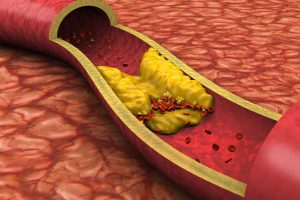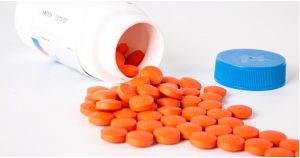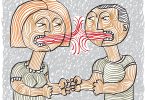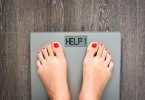Lifestyle changes can make a difference
High blood pressure, like stress, is one of those silent killers. In fact, it’s the leading associated cause of death and is the number one reason why people visit their doctor. So, it demands our attention.
High blood pressure, or hypertension, has a number of contributing factors. Age is one, stress is another, but there are others. A diet that is high in fats, cholesterol, and animal proteins can “clog the pipes” and lead to atherosclerosis, fatty deposits in the cardiovascular system. Or one that is high in salt can result in excessive fluid in the blood.

Human blood pressure is highly variable. The heart expands and contracts each second, so your blood pressure is high at one moment and low in the next. That’s why there are two measurements — pressure at its highest (systolic blood pressure or the lower number), and one a moment later, when it’s lowest (diastolic, or the lower number).
Medical professionals consider your blood pressure to be “high” when either your systolic blood pressure is 140 or above, or your diastolic blood pressure is 90 or above, or both. Most people with high blood pressure have a mild condition — their systolic blood pressure is between 140-159, and/or their diastolic blood pressure is between 90-99.
But you have to be careful about relying hard and fast numbers. For example, if your blood pressure is 136/88, you actually have five times the risk of stroke as compared to someone with blood pressure at 110/70. In fact, one-third of the people who die of heart attacks, strokes, and congestive heart failure have blood pressures that are below 140/90. That’s probably why the American Heart Association and the American College of Cardiology lowered the definition from 140/90 to 130/80.
Medical doctors rely heavily on drug therapy, making blood pressure drugs the number one prescription medication. But there are also changes you can make to your lifestyle so you might be able to rely less on pills. Some you’re familiar with, but there’s a few that might surprise you.

Exercise regularly
Regular exercise makes your heart stronger and more efficient. The recommended amount is 150 minutes per week of moderate, like walking, or 75 minutes of vigorous, such as running. Strength training also helps. And doing more reduces blood pressure even further.
Reduce salt
The biggest culprits are virtually all packaged foods, bread, cold cuts, pizza, poultry, bacon, hot dogs, and soups.
Even a small reduction in the sodium can improve your heart health and reduce blood pressure. In general, limit sodium to 2,300 milligrams (mg) a day or less. However, a lower sodium intake — 1,500 mg a day or less — is best for most adults.
To decrease sodium, you need to be conscious of what you’re eating. In other words, read the labels. And, of course, don’t add salt to season your food — a single teaspoon of salt has 2,300 mg of sodium. Instead, use herbs or spices to flavor your food.
Drink less alcohol
Drinking more than moderate amounts of alcohol can raise blood pressure by several points, and it can reduce the effectiveness of medications you taking. A moderate amount means no more than one drink a day for women and two for men. One drink is about 12 ounces of beer, five ounces of wine or 1.5 ounces of 80-proof liquor.
Eat more…
Berries — strawberries, raspberries, blackberries, and blueberries are rich in polyphenols, natural plant compounds that are good for your heart.
Dark chocolate 70 percent or more, or cocoa — they’re rich in flavonoids, plant compounds that cause blood vessels to dilate and so lower blood pressure.
Foods that contain probiotics—consumable live bacteria—has been linked to healthier blood pressure. These include yogurt, sauerkraut, miso, some cheeses (Gouda, mozzarella, cheddar and cottage cheese), and pickles.
Eat foods that are rich in…
Potassium — helps your body get rid of sodium and eases pressure on your blood vessels. Foods high in potassium include leafy green vegetables, tomatoes, potatoes and sweet potatoes, fruits such as melons, bananas, avocados, oranges and apricots, dairy products, tuna and salmon, nuts, and beans.
Magnesium — helps blood vessels relax, making it easier for blood to pass through. Foods rich in magnesium include vegetables, dairy, chicken, legumes, and whole grains.
Calcium — the calcium recommendation for women over 50 and men over 70 is 1,200 mg per day. In addition to dairy, you can get calcium from collard greens and other leafy green vegetables, beans, sardines and tofu.
Cut back on caffeine
The evidence is not clear that caffeine is linked to high blood pressure. It causes a short term spike, but long term harm has not been proven. Nevertheless, some people are more sensitive to caffeine’s effects, and if that’s you, cutting back might be helpful, especially late in the day. You might sleep better, and poor sleeping habits can contribute to high blood pressure.
Manage your stress levels
If you’re chronically stressed, you causing your heart to continuously beat fast and your blood vessels to constrict. We have a number of articles on what you can do to reduce your stress levels, and you can find them under Health and Well-being on the menu bar.
Lose weight
Losing 5% of your body mass could significantly lower blood pressure. It’s easier for blood vessels to expand and contract, and that takes some of the stress off your heart. In general, men are at risk if their waste measures more than 40 inches, and women at more than 35 inches.
Quit smoking
While the evidence is not conclusive that smoking increases blood pressure, it is linked to heart disease. Every puff of cigarette smoke causes a slight, temporary increase in blood pressure, and the chemicals in tobacco are known to damage blood vessels.
Cut sugar and refined carbs
Studies have shown that even moderate amounts of sugar, as little as one soda per day, can raise blood pressure. Refined carbohydrates, like white bread and pasta, covert to sugar quickly when they’re eaten. A better diet for hypertension is one that is rich in fruit, vegetables, unprocessed grains and cereals and fat-free milk, yogurt and cottage cheese.
Take natural supplements
Some natural supplements may also help lower blood pressure — aged garlic extract, Berberine, Whey protein, Fish oil, and Hibiscus
Show some love
There is evidence that hugging people can lower your blood pressure. A similar effect can occur from cuddling with pets or even just petting them.
Now, we should mention that even if you adopt all of these approaches, you might still need to take medications. So, don’t stop your pills until you’ve worked that out with your doctor.







